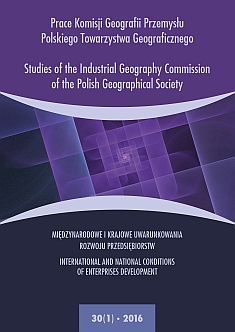Central and Eastern Europe Countries in View of Chinese Economic Expansion
Keywords:
Central and Eastern Europe, China, One Belt, One Road, 16 1Abstract
China is recently becoming one of the most important players in the world economy. The rapid economic growth causes numerous changes in domestic issues and international PRC’s activity. One of the most important fields of Chinese overseas operations are foreign direct investment, which grew significantly in last few years. Central and Eastern Europe (CEE) is a rather new area of Chinese international expansion. In this paper the selection of CEE countries is made in accordance with the 16+1 cooperation platform. It involves the post-communist countries: Estonia, Latvia, Lithuania, Poland, The Czech Republic, Slovakia, Hungary, Romania, Slovenia, Croatia, Serbia, Bosnia and Herzegovina, Montenegro, Bulgaria, Macedonia, Albania. Since 2011, there is an increasing political cooperation between China and sixteen CEE countries. It is annually realized on meetings of the representatives of every member of the platform. There is also a new concept created by Chinese authorities called “One Belt, One Road” which may influence this cooperation. This paper aims to examine the spatial diversification of bilateral relations between China and individual CEE states. It takes into account mainly the trade balance and Chinese monetary inflow in particular post-communist countries. The research shows that the trade relations are on the highest level in Poland and Czech Republic. The biggest investments were located in Hungary. It can be also seen that the Balkan countries signed a lot of infrastructural contracts which may be the consequences of the realization of “One Belt, One Road” strategy.
Downloads
Metrics
References
Bolesta, A. (2006). Chiny w okresie transformacji. Warszawa: Wydawnictwo Akademickie Dialog.
China Global Investment Tracker (2015, 30 listopada). American Enterprise Institute. Pozyskano z https://www.aei.org/china-global-investment-tracker/
Dixon, C. (2015). The New BRICS Bank: Challenging the International Financial Order? GPI Policy Paper, 28.
Dumitrescu, G.K. (2015). Central and Eastern European Countries Focus on the Silk Road Economic Belt. W: Global Economic Observer, 3(1), 186–197.
Garnaut, R., Song, L., Fang, C., Johnston, L. (red.) (2015). China’s domestic transformation in a global context. Australia: ANU Press.
Góralczyk, B. (2015, 18 października). Dyplomacja pieniądza. Obserwator finansowy. Pozyskano z http://www.obserwatorfinansowy.pl/tematyka/makroekonomia/dyplomacja-pieniadza/
Jakubowski, J. (2015, 30 października). Złe perspektywy gospodarcze utrudnią chińskie reformy. Ośrodek Studiów Wschodnich. Pozyskano z http://www.osw.waw.pl/pl/publikacje/analizy/ 2015-08-26/zle-perspektywy-gospodarcze-utrudnia-chinskie-reformy
Johnston, M. (2015, 22 października). China’s Economy: Transition to Sustainable Growth. Investopedia. Pozyskano z http://www.investopedia.com/articles/forex/091115/chinas-economy- -transition-sustainable-growth.asp?layout=infini&v=1B
Kaczmarski, M. (2015). Nowy Jedwabny Szlak: uniwersalne narzędzie chińskiej polityki. Komentarze Ośrodka Studiów Wschodnich, 161.
Kaczmarski, M., Jakubowski, J. (2015). Chiny – Europa Środkowo-Wschodnia: „16 + 1” widziane z Pekinu. Komentarze Ośrodka Studiów Wschodnich, 166.
Kissinger, H. (2014). O Chinach. Wołowiec: Wydawnictwo Czarne.
Knoerich, J. (2015, 15 października). China’s AIIB Dream. China Policy Institute Blog. Pozyskano z https://blogs.nottingham.ac.uk/chinapolicyinstitute/2015/06/03/chinas-aiib-dream/ Liang, S., Garnaut, R., Cai, F. (2014). Deepening Reform for China’s Long-term Growth and Development. Australia: ANU Press.
Liberska, B. (2010). Perspektywy rozwojowe chińskiej gospodarki do 2050 roku. W: Studia Ekonomiczne, 4, 331–358.
Liu, Z. (2013). The Pragmatic Cooperation between China and CEE: Characteristics, Problems, and Policy Suggestions. W: Working Papers Series on European Studies, 7(6). Pekin: Institute of European Studies, Chinese Academy of Social Sciences, 1–9.
Liu, Z. (2014). Central and Eastern Europe in Building the Silk Road Economic Belt. W: Working Papers Series on European Studies, 8(3). Pekin: Institute of European Studies, Chinese Academy of Social Sciences, 1–12.
Mitrović, D. (2014). China in the Western East – and Beyond: Politics and Economics of the China Plus Sixteen Cooperation Framework. W: Serbian Political Thought, 2. Belgrad: Institute for Political Studies, 19–50.
Renard, T. (2015). The Asian Infrastructure Investment Bank (AIIB): China’s new multilateralism and the erosion of the West. W: Security Policy Brief, 63. Egmont: The Royal Institute for International Relations, 1–7.
Shambaugh, D. (2013). China Goes Global: The Partial Power. Nowy Jork: Oxford University Press.
Song, L. (2013). From rediscovery to new cooperation: the relationship between China and Central and Eastern Europe. W: J. Men (red.). EU-China Observer, 5. Bruges: College of Europe, 8–14.
The State Council Information Office Holds a Press Conference on Statistical Communiqué of 2014 on China Direct Investment Overseas (2015, 8 paździenika). Ministry of Commerce People’s Republic of China (MOFCOM). Pozyskano z http://english.mofcom.gov.cn/article/newsrelease/ press/201509/20150901124461.shtml
Trailović, D., Kiculović, B. (2014). Economic and political implications of Chinese engagement in Central and Eastern European Countries. W: S. Scaunas, E. Strautiu, V. Tabara (red.). Political Science, International Relations and Security Studies. Sibiu: Lucian Blaga University of Sibiu, 196–203.
Turcsányi, R., Qiaoan, R., Kříž, Z. (2014). Coming From Nowhere: The Chinese Perception of the Concept of Central Europe. W: D. Mierzejewski (red.). The Quandaries of China’s Domestic and Foreign Development. Łódź: Wydawnictwo Uniwersytetu Łódzkiego, 155–171.
Vangeli, A. (2015, 30 września). The new kid in the block: a short intro to the China-WB relationship.Balkans in Europe Policy Blog. Pozyskano z http://www.suedosteuropa.uni-graz.at/biepag/ node/138
Żmuda, M. (2009). Przyczyny wejścia chińskiej republiki ludowej na ścieżkę przyspieszonego wzrostu gospodarczego. W: W. Michalczyk (red.). Wybrane problemy gospodarki światowej pierwszej dekady nowego wieku. Wrocław: Uniwersytet Ekonomiczny we Wrocławiu, Katedra Międzynarodowych Stosunków Gospodarczych, 93–101.
Downloads
Published
How to Cite
Issue
Section
License
Articles are published under the terms of the Creative Commons License (CC BY-ND 4.0; Attribution– NoDerivs).

